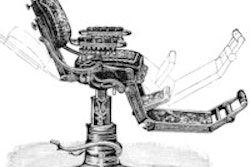
Changing your PACS is important for many reasons. It demonstrates data ownership is with the customer, and data are fluid and can be moved between vendors. Also, it provides an opportunity to upgrade the hardware (servers, storage, and workstation display), improve integration with other clinical systems -- thus boosting patient safety and clinical practices -- and take advantage of technological updates, particularly displays on mobile devices.
Furthermore, replacing PACS allows you to incorporate the vendor-neutral archive (VNA) with life cycle management, and introduce Cross-Enterprise Document Sharing (XDS) for registry and repository of nonradiological image and document management. It also gives data-cleansing opportunities and enables you to take advantage of the falling price of technology.
 Dr. Neelam Dugar is a consultant radiologist at Doncaster Royal Infirmary, U.K., and former chair of the Royal College of Radiologists' Imaging Informatics Group.
Dr. Neelam Dugar is a consultant radiologist at Doncaster Royal Infirmary, U.K., and former chair of the Royal College of Radiologists' Imaging Informatics Group.
At the end of August 2013, we completed the replacement of our PACS, switching from Agfa Healthcare to Fujifilm Medical Systems. Although our clinicians were happy with the Agfa PACS, overall it was a worthwhile exercise. This series of monthly articles will elaborate on the lessons that we have learned from the process.
Firstly, clinical input is essential. Change is always difficult for everybody, and doctors are no different in this respect. Managing change is easier if the users feel they have been involved in the decision-making and they have been listened to. All the senior doctors (about 300) in our hospital were invited to be involved in the choice of the PACS.
Two physicians, two orthopedic surgeons, and a vascular surgeon volunteered to give up their time for evaluating systems. Five days were required: two days of question-and-answer sessions with suppliers, two days of supplier demos, and a day of group scoring. They also put in some additional time to read and comment on the written specifications.
For the procurement process, we chose to tender through the Competitive Dialogue Procedure. In early 2012, a tender was issued by the Official Journal of the European Union (OJEU). As part of this procedure, we sent out a prequalification questionnaire (PQQ) to all suppliers who responded to our tender. This consisted of questions about the bidding company, experience in PACS and data migration, staffing levels, etc.
The PQQ also had some pass and fail mandatory questions based on the clinical requirements. Our PACS project board consisted of the project manager (PACS manager), radiology business manager, director of finance (or representative), head of IT (or representative), clinical lead of PACS, and a procurement manager. The board meetings were chaired by the director of finance, and to avoid any personal or individual bias, members scored all the PQQ responses as a group. All the seven bidders who passed the mandatory questions on PQQ were taken forward to the dialogue phase of the process.
Specifications and demonstrations
The detailed output-based specifications for the PACS were written by us in simple language. They constituted clinical and technical specifications, and were sent to all successful bidders after the PQQ phase. Initial question-and-answer sessions of approximately 1.5 hours were held with each bidder. This provided an opportunity for bidders to seek clarification on the specifications.
The specifications were updated to take account of the various comments by the bidders, and, once finalized, they were sent out again to all bidders with the various changes highlighted. No additional functionality was introduced. All bidders needed to respond to the specification in writing; written responses are extremely important when it comes to choosing the supplier and also for ensuring that suppliers do deliver what they have promised at the later stages.
All bidders were invited to demonstrate their software. About 25 items were required to be demonstrated to the team members, who consisted of the project board plus the five senior doctors who had volunteered. They were given about two hours each. All bidders were required to follow a defined script, and this prevented bias from bidders trying to show off a particular feature at the cost of important functionality.
Again, we did a group scoring by the five senior doctors and five of us from the Project Board (the procurement manager did not take part in the scoring but ensured there was fairness shown to all bidders). To score a bidder's written responses to our 50 items on the functional specifications for PACS and VNA, and also the 25 items on our scripted demo, we used the following criteria:
- Fully meets the requirements and very good (6)
- Meets the requirements and satisfactory (5)
- Meets the requirements (with development); will be ready for go live (4)
- Meets the requirements (with development); will develop within contract lifetime (defined time frame provided) (3)
- Meets the requirements, but is a poor design from a user's perspective and is cumbersome and almost unintuitive (2)
- Partly meets the requirements; no defined plans for development (1)
- Does not meet the requirements (0)
We also issued minimum mandatory clinical requirements, which required yes/no answers from the bidders. The bidders who met or were willing to meet the minimum mandatory requirements were invited to send in the total cost of the PACS and VNA system for seven years. From the written responses and demonstrations, we used an objective formula of the total cost divided by the total score to choose the successful bidder. In this way, we gave cost and functionality of the product equal importance in choosing the solution.
The suppliers who made it to the final stage were all very good, and the competition was very close indeed. The PACS market is excellent from a customer perspective. The tendering process for a large IT system was new to our hospital, but we all learned from this. We parted on good terms with all the suppliers who did not make it through the process because they felt they had been given a fair chance. Fujifilm was awarded preferred bidder standing in the third quarter of 2012.
Contract details
Wording the contract correctly and ensuring that both sides agree with what is expected are important for good future relationships. We had to secure some external help from professionals who had experience and expertise in the writing and understanding of a PACS contract. They continue to assist us with any changes and contract negotiations as and when required. All the content of the clinical output-based specifications and minimum mandatory specifications were clearly included in the contract documentation. This ensures that all the promises made to the clinical users will be delivered.
The contract was signed with Fujifilm in early 2013, and they are expected to provide us with a PACS solution for the next seven years. We knew we had a busy time ahead of us. We had more than 2 million studies that needed to be migrated across, and Fujifilm subcontracted the process to Acuo Technologies, which also took care of the VNA with life cycle management. DICOM Query Retrieve was used as the method of migration of data. This was successfully completed before going live.
The next part of this series on PACS replacement will concentrate on how we handled data migration, integration, etc.
Dr. Neelam Dugar is consultant radiologist at Doncaster Royal Infirmary, U.K., and former chair of the Royal College of Radiologists' Imaging Informatics Group.
The comments and observations expressed herein do not necessarily reflect the opinions of AuntMinnieEurope.com, nor should they be construed as an endorsement or admonishment of any particular vendor, analyst, industry consultant, or consulting group.



















